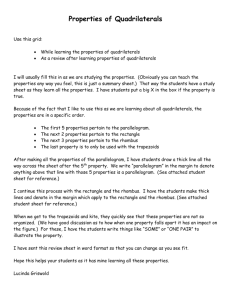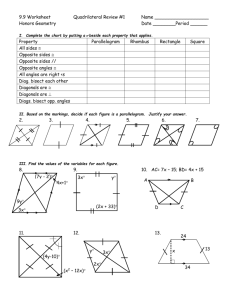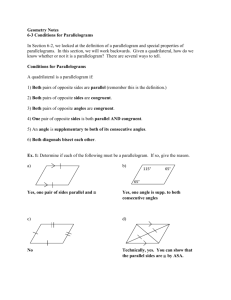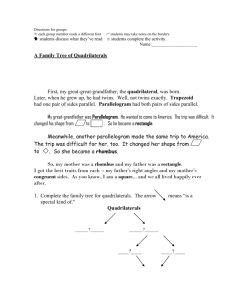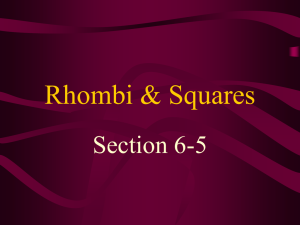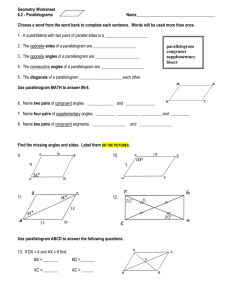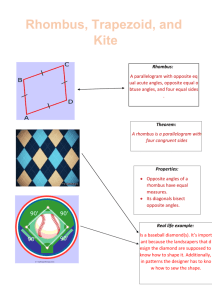Chapter 6 Practice Exam
advertisement
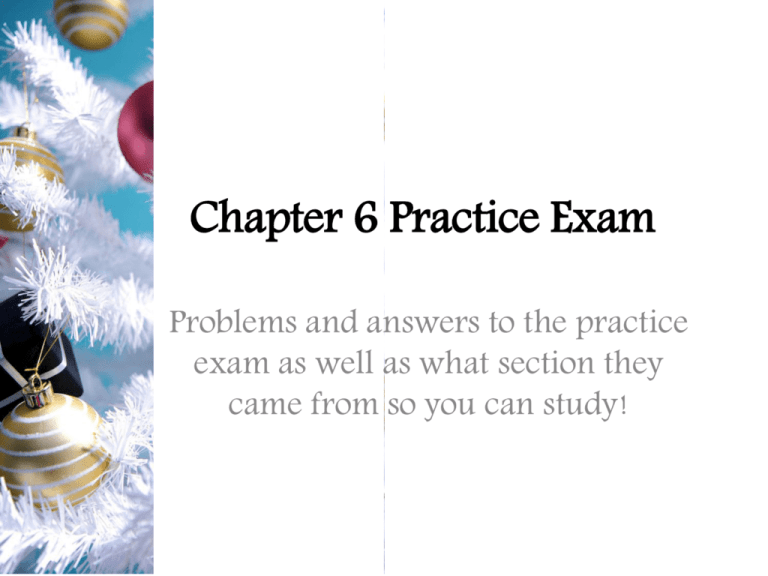
Chapter 6 Practice Exam Problems and answers to the practice exam as well as what section they came from so you can study! 1. What is the sum of the angle measures of a 35-gon? 5940 6660 6120 6300 38% 24% 63 00 61 20 19% 66 60 19% 59 40 A. B. C. D. 1. What is the sum of the angle measures of a 35-gon? 𝑛 − 2 180 = 𝑡𝑜𝑡𝑎𝑙 𝑑𝑒𝑔𝑟𝑒𝑒𝑠 𝑖𝑛 𝑎 𝑝𝑜𝑙𝑦𝑔𝑜𝑛 35 − 2 180 = 33 180 = 5940 Correct Answer is A. 5940 6-1 2. Find the missing values of the variables. The diagram is not to scale. 119° 52% 29% =1 19 𝑥 𝑦 =1 03 ; =7 4 𝑦 =9 3; 𝑥 𝑥 𝑦 =9 3 10% =7 4; =1 03 10% =7 4; 𝑥 = 74; 𝑦 = 103 𝑥 = 74; 𝑦 = 93 𝑥 = 93; 𝑦 = 74 𝑥 = 103; 𝑦 = 119 𝑦 A. B. C. D. 74° 𝑥 106° x° y° 2. Find the missing values of the variables. The diagram is not to scale. 119° 106° x° y° 74° 106 + 𝑦 = 180 𝑦 = 74 𝑥 + 𝑦 + 119 + 74 = 360 𝑥 + 74 + 74 + 119 = 360 𝑥 + 267 = 360 𝑥 = 93 Correct answer is C. 𝑥 = 93; 𝑦 = 74 6-1 3. How many sides does a regular polygon have if each exterior angle measures 30? A. B. C. D. 15 sides 12 sides 14 sides 11 sides 62% 24% 14% 0% 3. How many sides does a regular polygon have if each exterior angle measures 30? 360 = 𝑒𝑥𝑡𝑒𝑟𝑖𝑜𝑟 𝑎𝑛𝑔𝑙𝑒 𝑚𝑒𝑎𝑠𝑢𝑟𝑒 𝑜𝑓 𝑎 𝑟𝑒𝑔𝑢𝑙𝑎𝑟 𝑝𝑜𝑙𝑦𝑔𝑜𝑛 𝑛 360 = 30 𝑛 360 =𝑛 30 𝑛 = 12 Correct answer is B. 12 sides 6-1 4. Find the values of the variables in the parallelogram. The diagram is not to scale. 31 67% 96 19% 10% 5% 𝑥 𝑧 =1 27 =9 6 𝑦 =3 1, 𝑥 =3 𝑧 1, =5 3, 𝑦 =5 3, =1 27 𝑧 =5 𝑧 3, =5 3, 𝑦 =3 1, = 53, 𝑦 = 31, 𝑧 = 96 = 53, 𝑦 = 53, 𝑧 = 127 = 31, 𝑦 = 53, 𝑧 = 96 = 31, 𝑦 = 53, 𝑧 = 127 𝑥 𝑥 𝑥 𝑥 𝑥 𝑥 A. B. C. D. 𝑦 x° =5 3, z° =9 6 y° 4. Find the values of the variables in the parallelogram. The diagram is not to scale. 31 𝑆𝑖𝑛𝑐𝑒 𝑥 𝑖𝑠 𝑡ℎ𝑒 𝑎𝑙𝑡𝑒𝑟𝑛𝑎𝑡𝑒 𝑖𝑛𝑡𝑒𝑟𝑖𝑜𝑟 𝑎𝑛𝑔𝑙𝑒 𝑡𝑜 31𝑜 𝑥 = 31 96 𝐴𝑛𝑑 𝑜𝑝𝑝𝑜𝑠𝑖𝑡𝑒 𝑎𝑛𝑔𝑙𝑒𝑠 𝑜𝑓 𝑎 𝑝𝑎𝑟𝑎𝑙𝑙𝑒𝑙𝑜𝑔𝑟𝑎𝑚 𝑎𝑟𝑒 𝑐𝑜𝑛𝑔𝑟𝑢𝑒𝑛𝑡 𝑠𝑜 𝑧 = 96𝑜 y° z° x° 6-2 𝐴𝑛𝑑 𝑥 + 𝑦 + 96 = 180 31 + 𝑦 + 96 = 180 𝑦 + 127 = 180 𝑦 = 53 Correct answer is C. 𝑥 = 31; 𝑦 = 53; 𝑧 = 96 5. Find AM in the parallelogram if PN =15 and AO = 6. The diagram is not to scale. M N A. B. C. D. A P O 38% 38% 19% .5 5 6 2 5% 12 6 15 7.5 5. Find AM in the parallelogram if PN =15 and AO = 6. The diagram is not to scale. M N A P O The diagonals of a parallelogram bisect each other If AO = 6 then AM = 6. Correct answer is B. 6 6-2 6. LMNO is a parallelogram. If NM = x + 5 and OL = 2x + 3, find the value of x and then find NM and OL. O A. B. C. D. 𝑥 𝑥 𝑥 𝑥 N L = 4, 𝑁𝑀 = 2, 𝑁𝑀 = 2, 𝑁𝑀 = 4, 𝑁𝑀 = 9, 𝑂𝐿 = 9 = 7, 𝑂𝐿 =7 = 9, 𝑂𝐿 = 7 = 7, 𝑂𝐿 = 9 M 62% 19% 10% 10% 6. LMNO is a parallelogram. If NM = x + 5 and OL = 2x + 3, find the value of x O and then find NM and OL. N L M Opposite sides of a parallelogram are congruent so NM = OL. 𝑥 + 5 = 2𝑥 + 3 2=𝑥 𝑃𝑙𝑢𝑔𝑔𝑖𝑛𝑔 𝑏𝑎𝑐𝑘 𝑖𝑛 𝑥: 2+5=7 2 2 +3=4+3= 7 6-2 Correct answer is B. 𝑥 = 2, 𝑁𝑀 = 7, 𝑂𝐿 =7 7. In the figure, the horizontal lines are parallel and AB = 𝐵𝐶 = 𝐶𝐷. Find JM. The diagram is not to scale. M A 9 D 48% 38% 10% 18 5% 9 J C 27 36 9 18 36 K B 27 L A. B. C. D. 7. In the figure, the horizontal lines are parallel and AB = 𝐵𝐶 = 𝐶𝐷. Find JM. The diagram is not to scale. M A 9 L K J B C D Since the lines are parallel and equidistant, 𝑀𝐿 = 𝐿𝐾 = 𝐾𝐽. The distance from 𝐽𝑀 = 9 + 9 + 9 = 27. Correct answer is A. 27 6-2 8. Based on the information given, can you determine that the quadrilateral must be a parallelogram? Explain. 𝐺𝑖𝑣𝑒𝑛: 𝑋𝑁 = 𝑁𝑍 and 𝑁𝑌 = 𝑁𝑊 X Y 43% 29% 14% 14% m i.. l. . . al a. ca n ou No ;y go na ls no t of a de te r pa r sid es Ye s ;d ia o ;t w Ye s Z Ye s W ;o pp os ite sid op po sit e es ar e c.. . . N A. Yes; opposite sides are congruent. B. Yes; two opposite sides are both parallel and congruent. C. Yes; diagonals of a parallelogram bisect each other. D. No; you cannot determine that the quadrilateral is a parallelogram. 8. Based on the information given, can you determine that the quadrilateral must be a parallelogram? Explain. 𝐺𝑖𝑣𝑒𝑛: 𝑋𝑁 = 𝑁𝑍 and 𝑁𝑌 = 𝑁𝑊 X Y N W Z Since you are given that the diagonals bisect each other yes the quad is a parallelogram. Correct answer is C. Yes; diagonals of a parallelogram bisect each other. 6-3 9. Find values of x and y for which ABCD must be a parallelogram. The diagram is not to scale. A B 3x – 14 y + 11 4y – 7 x+ 2 24% 19% =1 0 =1 7 =8 , 𝑦 =8 𝑥 , 𝑦 𝑦 =8 𝑥 𝑥 =6 , =6 10% , = 8, 𝑦 = 6 = 6, 𝑦 = 8 = 8, 𝑦 = 17 = 8, 𝑦 = 10 =8 𝑥 𝑥 𝑥 𝑥 48% 𝑦 A. B. C. D. C 𝑥 D 9. Find values of x and y for which ABCD must be a parallelogram. The diagram is not to scale. A B 3x – 14 y + 11 4y – 7 x+ 2 D 3𝑥 − 14 = 𝑥 + 2 2𝑥 = 16 𝑥=8 C 4𝑦 − 7 = 𝑦 + 11 3𝑦 = 18 𝑦=6 Correct answer is A. 𝑥 = 8, 𝑦 = 6 6-3 10. Based on the information in the diagram, can you prove that the figure is a parallelogram? Explain. 33% 29% 24% c.. . go na ls ar e sid es ;t he Ye s o ;t w Ye s di a et op po sit e pr ov no t ca n ou No ;y a. .. ha . .. ct . bi se ls go na di a ;t he Ye s . 14% A. Yes; the diagonals bisect each other. B. No; you cannot prove that the quadrilateral is a parallelogram. C. Yes; two opposite sides are both parallel and congruent. D. Yes; the diagonals are congruent. 10. Based on the information in the diagram, can you prove that the figure is a parallelogram? Explain. Yes because the diagonals bisect each other the figure will be a parallelogram. Correct answer is A. Yes; the diagonals bisect each other. 6-3 11. In the rhombus, 𝑚∠1 = 140. What are 𝑚∠2 and 𝑚∠3? The diagram is not to scale. | 67% | 1 19% 3 10% 70 ∠ 𝑚 𝑚 ∠ 3= 20 2= 14 0, 3= ∠ 𝑚 40 , 𝑚 ∠ 2= 𝑚 ∠ 3= ∠ 𝑚 ∠ 2= 14 0, 𝑚 ∠ 𝑚∠2 = 40, 𝑚∠3 = 70 𝑚∠2 = 140, 𝑚∠3 = 20 𝑚∠2 = 40, 𝑚∠3 = 20 𝑚∠2 = 140, 𝑚∠3 = 70 𝑚 A. B. C. D. 2= 40 , 3= 70 2 20 | | 5% | 1 | 11. In the rhombus, 𝑚∠1 = 140. What are 𝑚∠2 and 𝑚∠3? The diagram is not to scale. | | 3 2 Since it is a rhombus opposite angles are congruent so 𝑚∠2 = 140. 140 + 140 + 𝑥 + 𝑥 = 360 280 + 2𝑥 = 360 2𝑥 = 80 𝑥 = 40 And a rhombus has diagonals that bisect the opposite angles therefore 𝑚∠3 = 20. Correct answer is B. 𝑚∠2 = 140, 𝑚∠3 = 20. 6-4 12. Which description does NOT guarantee that a quadrilateral is a square? 43% 24% 19% ... nd h. . d . .. ith nt a .. 14% A. has all sides congruent and all angles congruent B. is a parallelogram with perpendicular diagonals C. has all right angles and has all sides congruent D. is both a rectangle and a rhombus 12. Which description does NOT guarantee that a quadrilateral is a square? -has all sides congruent and all angles congruent must be both rhombus and rectangle so square -has all right angles and has all sides congruent must be both rectangle and rhombus so square -is both a rectangle and a rhombus Therefore it is a square equal sides and all right angles. BUT B. is a parallelogram with perpendicular diagonals A rhombus has perpendicular diagonals but it does not have to be square, there fore the correct answer is B. 6-4 13. DEFG is a rectangle. DF = 5x – 3 and EG = x + 5. Find the value of x and the length of each diagonal. = 6, 𝐸𝐺 = 7, 𝐸𝐺 = 6, 𝐸𝐺 = 7, 𝐸𝐺 =6 = 12 =6 =7 57% 19% 19% =7 𝐺 =7 , =6 𝐺 =6 7, , =6 =1 2 5% 𝐺 = 1, 𝐷𝐹 = 2, 𝐷𝐹 = 2, 𝐷𝐹 = 2, 𝐷𝐹 , 𝑥 𝑥 𝑥 𝑥 =6 A. B. C. D. 13. DEFG is a rectangle. DF = 5x – 3 and EG = x + 5. Find the value of x and the length of each diagonal. 𝐷𝑖𝑎𝑔𝑜𝑛𝑎𝑙𝑠 𝑜𝑓 𝑎 𝑟𝑒𝑐𝑡𝑎𝑛𝑔𝑙𝑒 𝑎𝑟𝑒 𝑐𝑜𝑛𝑔𝑟𝑢𝑒𝑛𝑡 𝑠𝑜 𝐷𝐹 = 𝐸𝐺 5𝑥 − 3 = 𝑥 + 5 4𝑥 = 8 𝑥=2 𝑃𝑙𝑢𝑔𝑔𝑖𝑛𝑔 𝑥 𝑏𝑎𝑐𝑘 𝑖𝑛 𝑤𝑒 𝑔𝑒𝑡: 5 2 −3=7 2+5=7 Correct answer is D. 𝑥 = 2, 𝐷𝐹 = 7, 𝐸𝐺 = 7 6-4 14. Which statement is true? A. All squares are rectangles. B. All quadrilaterals are rectangles. C. All parallelograms are rectangles. D. All rectangles are squares. 38% 29% 24% es . ar ... re .. . ec ng le s. 10% 14. Which statement is true? -All quadrilaterals are rectangles. Not true could be a rhombus, kite, etc. -All parallelograms are rectangles. Not true could be a rhombus. -All rectangles are squares. Not true some do not have all sides congruent. • All squares are rectangles. This statement is always true to be a square it must have 4 right angles which makes it a rectangle. Correct answer is A. All squares are rectangles. 6-4 15. Parallelogram ABCD has the angle measures shown. Can you conclude that it is a rhombus, a rectangle, or a square? Explain. 62% 19% 14% in f. . . h a. .. is CD a. is D D is a. .. .. 5% 66º 66º 66º 66º A. Parallelogram ABCD is a rectangle, because the diagonal creates congruent angles. B. Parallelogram ABCD is a square, because all four angles have the same measure. C. Parallelogram ABCD is a rhombus, because the diagonal bisects two angles. D. There is not enough information. 15. Parallelogram ABCD has the angle measures shown. Can you conclude that it is a rhombus, a rectangle, or a square? Explain. 66º 66º 66º 66º -Parallelogram ABCD is a rectangle, because the diagonal creates congruent angles. Not true rectangles do not bisect the opposite angles. -Parallelogram ABCD is a square, because all four angles have the same measure. Not square 66 + 66 is not a right angle. -Parallelogram ABCD is a rhombus, because the diagonal bisects two angles. YES a rhombus does bisect the opposite angles. Correct answer is C. 6-5 16. In quadrilateral ABCD, 𝐴𝐸 = 𝑥 + 6 and 𝐵𝐸 = 3𝑥 − 18. For what value of x is ABCD a rectangle? A B A. B. C. D. E D C 71% 14% 14 16 5% 12 18 10% 18 12 16 14 16. In quadrilateral ABCD, 𝐴𝐸 = 𝑥 + 6 and 𝐵𝐸 = 3𝑥 − 18. For what value of x is ABCD a rectangle? A B E D C 𝐷𝑖𝑎𝑔𝑜𝑛𝑎𝑙𝑠 𝑖𝑛 𝑎 𝑟𝑒𝑐𝑡𝑎𝑛𝑔𝑙𝑒 𝑎𝑟𝑒 𝑐𝑜𝑛𝑔𝑟𝑢𝑒𝑛𝑡 𝑠𝑜 AE = BE. 𝑥 + 6 = 3𝑥 − 18 24 = 2𝑥 12 = 𝑥 Correct answer is B. 12 6-5 17. In quadrilateral ABCD, 𝑚∠𝐴𝐶𝐷 = 2𝑥 + 4 and 𝑚∠𝐴𝐶𝐵 = 5𝑥 − 8. For what value of x is ABCD a rhombus? A B A. B. C. D. D 3 4 5 6 C 52% 29% 19% 0% 17. In quadrilateral ABCD, 𝑚∠𝐴𝐶𝐷 = 2𝑥 + 4 and 𝑚∠𝐴𝐶𝐵 = 5𝑥 − 8. For what value of x is ABCD a A B rhombus? D C To be a rhombus the diagonals must bisect the opposite angles. 2𝑥 + 4 = 5𝑥 − 8 12 = 3𝑥 4=𝑥 The correct answer is B. 4. 6-5 18. 𝐽 𝑎𝑛𝑑 ∠𝐾 𝑎𝑟𝑒 𝑏𝑎𝑠𝑒 𝑎𝑛𝑔𝑙𝑒𝑠 𝑜𝑓 𝑎𝑛 𝑖𝑠𝑜𝑠𝑐𝑒𝑙𝑒𝑠 𝑡𝑟𝑎𝑝𝑒𝑧𝑜𝑖𝑑 𝐽𝐾𝐿𝑀. 𝐼𝑓 𝑚∠𝐽 = 18𝑥 + 8 , 𝑎𝑛𝑑 𝑚∠𝑀 = 11𝑥 + 15, 𝑓𝑖𝑛𝑑 𝑚∠𝐾 A.1 B. 154 C. 77 D.26 67% 33% 26 77 0% 15 4 1 0% 18. 𝐽 𝑎𝑛𝑑 ∠𝐾 𝑎𝑟𝑒 𝑏𝑎𝑠𝑒 𝑎𝑛𝑔𝑙𝑒𝑠 𝑜𝑓 𝑎𝑛 𝑖𝑠𝑜𝑠𝑐𝑒𝑙𝑒𝑠 𝑡𝑟𝑎𝑝𝑒𝑧𝑜𝑖𝑑 𝐽𝐾𝐿𝑀. 𝐼𝑓 𝑚∠𝐽 = 18𝑥 + 8 , 𝑎𝑛𝑑 𝑚∠𝑀 = 11𝑥 + 15, 𝑓𝑖𝑛𝑑 𝑚∠𝐾 Base angles of an isosceles trapezoid are congruent. 18𝑥 + 8 = 11𝑥 + 15 7𝑥 = 7 𝑥=1 Plugging back into the equations we see the following: 𝑚∠𝐽 = 18 1 + 8 = 26 𝑚∠𝑀 = 11 1 + 15 = 26 However the question asked for angle K which is supplementary 180 − 26 = 154 Correct answer then is B. 154. 6-6 19. Find 𝑚∠1 and 𝑚∠3 in the kite. The diagram is not to scale. | ∠ ∠ 𝑚 73 , 1= 𝑚 ∠ 73 , ∠ 1= 3= 73 0% 17 0% 3= 17 3= 17 , ∠ ∠ 𝑚 1= 𝑚 𝑚 ∠ 1= 17 , 3= 73 0% 𝑚 B 𝑚 2 ∠ 1 || || D 3 17° 100% 𝑚 | A C A. B. C. D. 𝑚∠1 = 17, 𝑚∠3 = 73 𝑚∠1 = 17, 𝑚∠3 = 17 𝑚∠1 = 73, 𝑚∠3 = 17 𝑚∠1 = 73, 𝑚∠3 = 73 19. Find 𝑚∠1 and 𝑚∠3 in the kite. The diagram is not to scale. | A 2 Angle three can be found using the triangle. B 17 + 90 + 𝑚∠3 = 180 107 + 𝑚∠3 = 180 || || D 3 17° 1 | The measure of angle 1 is the same as 17 since they are corresponding parts in congruent triangles. 𝑚∠3 = 73 Correct answer is A. 𝑚∠1 = 17, 𝑚∠3 = 73 C 6-6 20. Find the values of the variables and the lengths of the sides of this kite. 100% || A. B. C. D. 𝑥 𝑥 𝑥 𝑥 = 9, 𝑦 = 14; 11, 20 = 14, 𝑦 = 9; 11, 11 = 14, 𝑦 = 9; 6, 16 = 9, 𝑦 = 14; 6, 16 16 =1 4; 6, 16 ;6 , 𝑥 𝑦 =9 , =9 𝑦 =1 4, =9 𝑦 =1 4, 𝑦 0% 𝑥 𝑥 =9 , =1 4; 11 ,2 0 x + 11 0% ;1 1, 11 0% 𝑥 || 2x + 2 x+ 2 | y–3 | x+ 2 || || y–3 | | 20. Find the values of the variables and the lengths of the sides of this kite. 2x + 2 x + 11 The top two sides are congruent and the bottom two sides are congruent so for ease solve the bottom two first they both have x. 2𝑥 + 2 = 𝑥 + 11 𝑥=9 Plugging into the top equations you get: 9 + 2 = 11 𝑦 − 3 = 11 𝑦 = 14 Plugging into the bottom equations: 2 9 + 2 = 20 𝑎𝑛𝑑 9 + 11 = 20 Correct answer is A. 𝑥 = 9, 𝑦 = 14; 11, 20 6-6 Chapter 6 Exam • We will test tomorrow Journals will be due at the end of the test. • Go over exams on Thursday. • RETEST Friday • Portfolios due on Monday!

